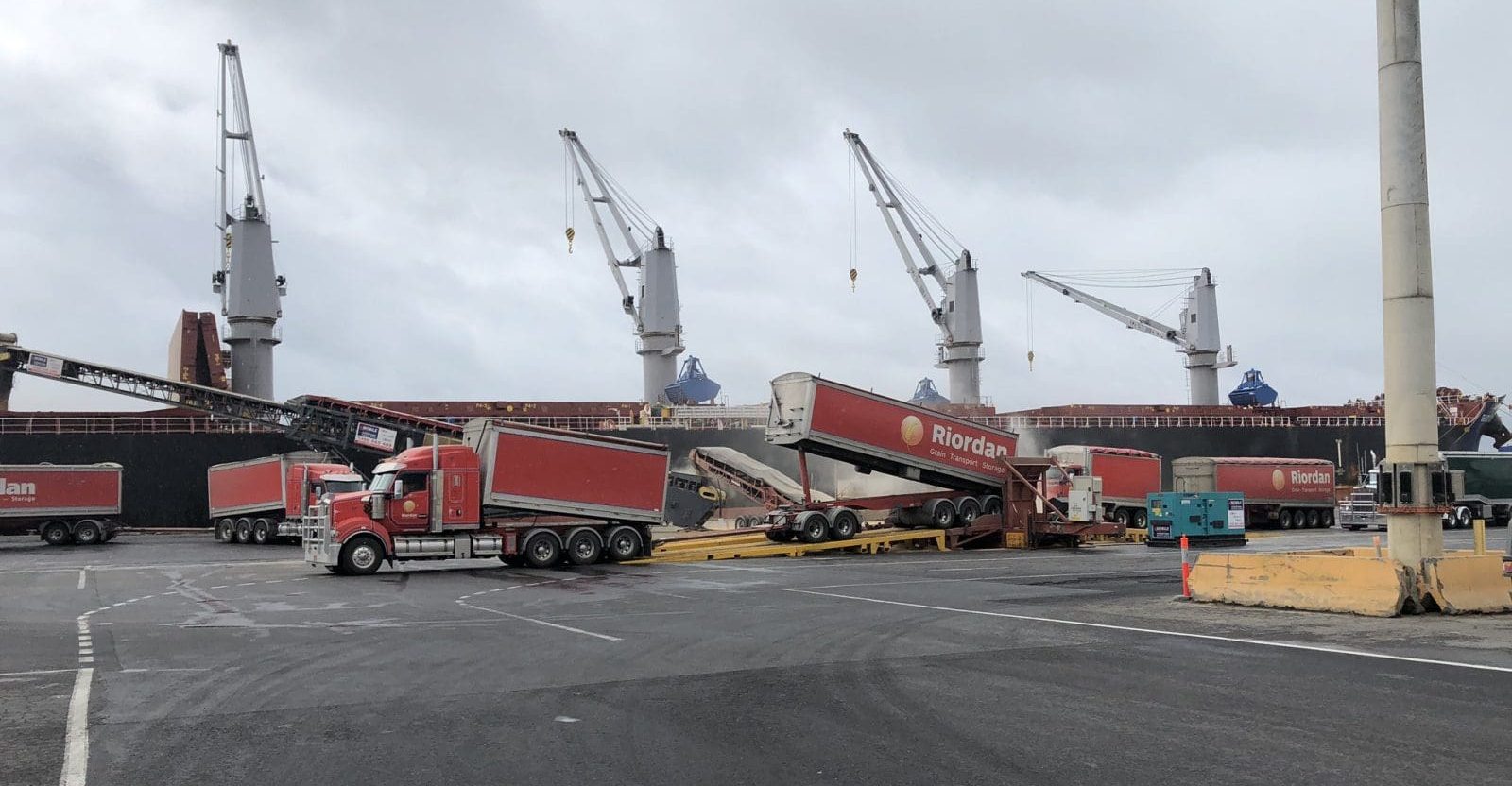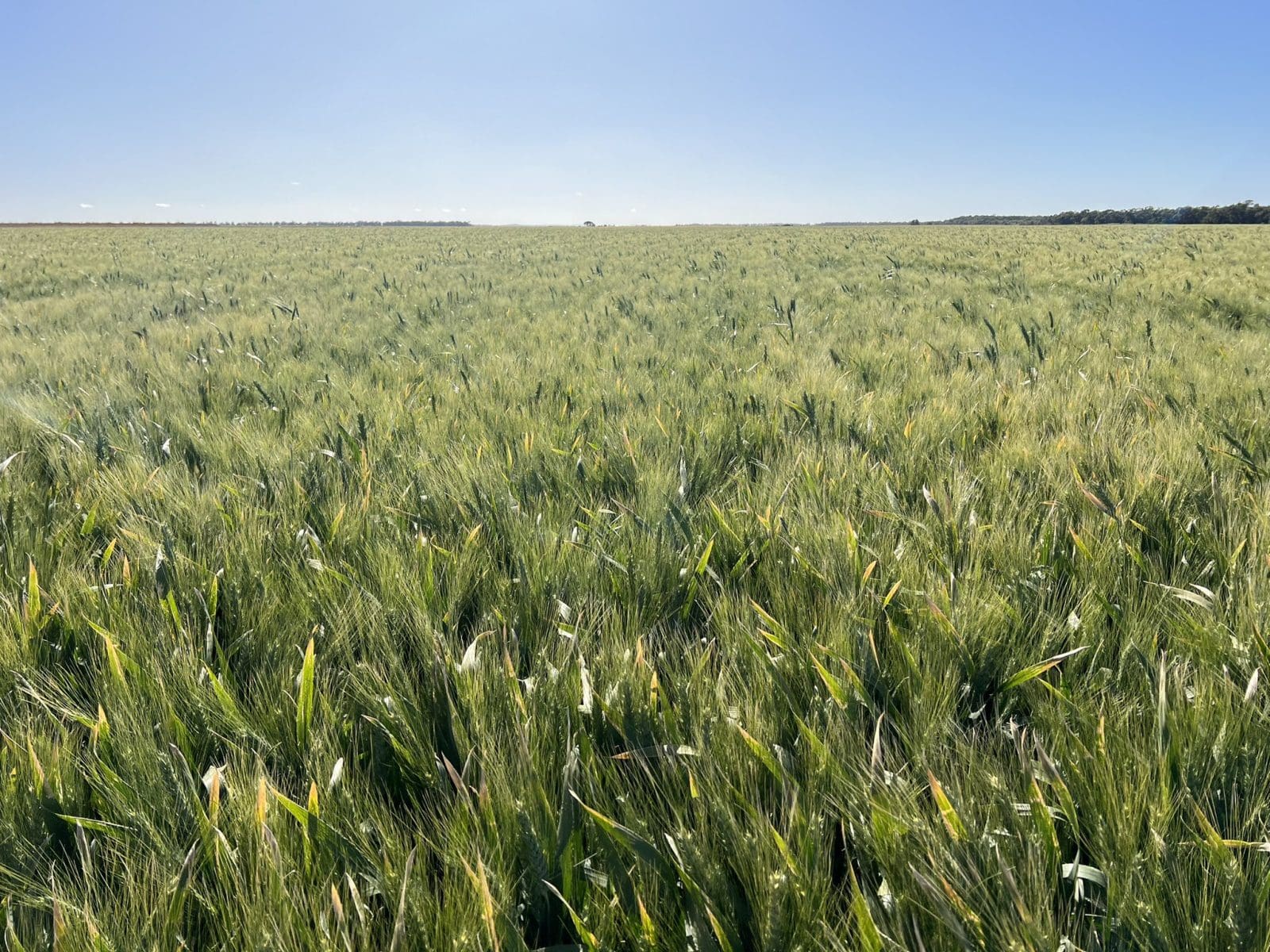
Riordan Grain Services loaded 52,000t of durum from southern NSW and bound for Algeria for client Flexi Grain at the Port of Geelong last month. Photo: Flexi Grain
A CARGO of old-crop durum on its way to Algeria proves that export demand for the prized grain is alive and well.
Put together by Flexi Grain, the 52,000-tonne cargo was loaded in Geelong by Riordan Grain Services, and sourced from 23 growers in southern New South Wales.
Flexi Grain pool manager Sam Roache said the cargo is the culmination of many months of work, and follows the company’s foray into durum in 2021-22 (Oct-Sep).
“We identified growers who had mentioned marketing issues with durum…and we had a pretty good marketing performance,” Mr Roache said.
Flexi Grain sold durum from its initial 2021-22 pool into the domestic market, and posted solid returns for growers.
“That was well received, and we got a massive interest in the second year.”
Mr Roache said growers participating in the Algeria sale could expect to receive around $60/t over harvest and immediate post-harvest values.
“We made a pathway to bring it to international market, and we’d like to roll out what we’re doing further north.”
Mr Roache said bulk loading of durum in NSW ports as well as Geelong, possibly in two-port loads, could be an option for Flexi Grain pools in seasons to come, but southern NSW has been the epicentre of interest to date.
“We’ve got demand from the Riverina as growers there look for liquidity.”
Riverina export avenue needed
The Riverina has a proven ability to produce high-quality irrigation durum that at a comfortable 10t per hectare in kind seasons can consistently out-yield bread wheat.
However, the Riverina’s distance from Australia’s semolina mills, and established export supply chains, puts it at a price disadvantage which sometimes pushes high-quality product into the region’s feed market.
Adelaide pasta manufacturer San Remo is Australia’s biggest semolina producer, and sources durum from South Australia and Victoria.
Provided quality parameters are met, San Remo is expected to buy almost all of SA’s durum crop now being harvested and estimated at 83,240t from 28,800ha by the Primary Industries and Regions, South Australia in its September Crop and Pasture Report.
This is down 3o percent on SA’s 2022-23 crop estimated by PIRSA at 118,500t from the same area.
No estimates for the NSW or Vic crop are available, but both states are expected to produce a small export surplus from the current harvest, partly because San Remo will be looking for additional tonnage out of Vic.
Australia’s other significant consumers of durum are Victoria’s Rinoldi, the maker of Nanda and Vetta pasta, Bellata Gold at Tamworth, and Manildra Group’s Gunnedah mill, both in northern NSW.
Australia’s semolina mills generally contract tonnage with long-term growers, and container packers and bulk exporters compete for the surplus, provided the domestic feed market is not bidding up big for the generally high-protein grain.
Because of their distance from domestic semolina mills, Mr Roache said Riverina growers have until now seen prices that reflect the tail end of demand, or a lack of demand altogether.
“If there’s a big crop around Adelaide, it’s not so good for them.”

Riordan Grain Services pre-accumulated 25,000t of durum in Geelong and brought the rest direct from southern NSW for Flexi Grain’s first bulk durum cargo now heading for Algeria on the vessel Genco Laddey. Photo: Flexi Grain
Small NSW crop now being harvested
Durum has become a valuable inclusion in Riverina rotations because of its gross margin advantage over bread wheat, and also its shorter growing season, which allows it to slot in after cotton.
Griffith-based agronomist and Ag Grow director Barry Haskins said this harvest’s Riverina durum crop will be a small one.
“We’ve got a few growers this year, but nothing compared to normal,” Mr Haskins said.
“There will be a commercial quantity, but not a lot.”
As was the case throughout NSW, planting seed free of mycotoxins was hard to find after last year’s sodden harvest, and growers shied away for an option with less disease risk.
“Bread wheat mostly has replaced it.”

An irrigated crop of Vittaroi durum nears the end of grain fill last month in the Riverina. Photo: Barry Haskins
Timing has also been a factor in reducing the Riverina’s durum area which will be harvested in coming weeks.
Mr Haskins said a lot of growers in the southern Murrumbidgee, where flooding was widespread last year, had cotton that was still in the field well past its normal picking date, and planting any sort of winter crop was therefore not possible.
On the Liverpool Plains, Mullaley grower Ross Durham said the disease risk from crown rot was considerable this season, and he therefore opted not to plant durum, normally a cornerstone of his rotation.
“We’ve gone canola and bread wheat instead,” Mr Durham said.
This season’s bread wheat was sown into last year’s canola stubble, which went into the previous season’s durum stubble.
Given last year’s sodden season, Mr Durham said crown rot would have carried over into durum planted this year, and the very dry growing season and finish has made him glad to be without durum this year.
“It’s only two years from the previous durum crop…and I’m sure crown rot would have expressed itself this year.”
Durum is notoriously susceptible to crown rot in dry years, which leads to pinched grain and high screenings that knock the grain out of top grades.
Northern price shocks common
Once domestic and export orders are filled, durum is also renowned in NSW for bids going over a cliff.
“They can drop by $50 a tonne.”
“A lot of people are disappointed with trying to market it at the back of harvest.
“There needs to be a higher reward, and growers need more certainty if they’re going to grow it.”
With its big nitrogen requirement, and unforgiving requirement for fungal control at flowering, Mr Durham said durum was an expensive crop to grow.
“We really need a premium of $30-$40/t over bread wheat to make it worthwhile.”
However, the top durum grades of DR1 and DR2 often trade at a discount to the premium bread wheat grades of APH1 and APH2.
Impressive yields from bread wheats, even in this year with minimal in-crop rain in much of northern NSW, are also swaying some growers away from durum, with their superior disease package an additional sweetener.
“There are some bread wheats that have a lesser risk for crown rot.”
Mr Durham estimates the Liverpool Plains durum area now close to harvest might be down around 25pc on last year.
An even greater drop is evident on the north-west plains of NSW, where the very dry start combined with concerns about crown rot in this El Niño year made many growers park it for the same reasons Mr Durham did.
Pioneer durum exporter and Grain Trend director Peter Howard also sees Queensland and NSW durum areas being well down on last year, and limited export surplus in the north.
He said the prospect of a drought-reduced crop from Canada lifted prices around the middle of the 2022-23 marketing year, but Australia had little to offer.
“Turkiye had a binbuster, which calmed the market down…but there is potential things can pick up.”
“Our old-crop was hopeless with mycotoxin; it was so wet during the growing season that conditions were ideal for it.”
It meant very little top-grade DR1 was delivered last year for export, but DR2 and DR3 was in good supply, with quality generally better in growing regions other than northern NSW.
| DURUM 21-22 | Oct-Dec | Jan-Mar | Apr | May | Jun | TOTAL |
| Algeria | 0 | 52148 | 0 | 0 | 0 | 52148 |
| Italy | 27706 | 29411 | 27055 | 0 | 0 | 84172 |
| Japan | 0 | 5665 | 0 | 0 | 0 | 5665 |
| Philippines | 502 | 508 | 0 | 0 | 0 | 1010 |
| Vietnam | 0 | 450 | 0 | 0 | 0 | 450 |
| TONNES | 28208 | 88182 | 27055 | 0 | 0 | 143445 |
Table 1: Bulk Australian durum exports from October 2021 to September 2022. Source: ABS
| DURUM 22-23 |
Oct-Dec | Jan-Mar | Apr | May | Jun | TOTAL |
| Bangladesh | 10238 | 0 | 0 | 0 | 0 | 0 |
| Italy | 0 | 21838 | 0 | 0 | 0 | 0 |
| Spain | 0 | 31500 | 0 | 0 | 0 | 0 |
| Tunisia | 0 | 0 | 0 | 27500 | 0 | 27500 |
| Turkiye | 0 | 0 | 32743 | 0 | 0 | 32743 |
| Vietnam | 0 | 0 | 31500 | 27500 | 0 | 60243 |
| TONNES | 10238 | 53338 | 64243 | 55000 | 0 | 119243 |
Table 2: Bulk Australian durum exports from October 2022 to June 2023. Source: ABS
While a national durum estimate is not publicly available, indications are that around 350,000t will be harvested, with a big year in Vic partly offsetting lower production forecast in SA, NSW and Qld.
Last year’s national durum crop was thought to be more like 400,000t, with bumper production in SA and Vic offsetting the flood-affected NSW crop.
Better quality expected
Mycotoxins, in particular deoxynivalenol, or DON, detected at anything above negligible levels crash the value of durum because they pose risks to animal and human health.
They occur in wet years in crops with fusarium head blight, when the fusarium graminearum fungus proliferates, while in dry years, its co-existing relative fusarium pseudograminearum can cause crown rot.
NSW DPI plant pathologist Steven Simpfendorder said growers and agronomists were well aware of the disease risk for durum planted this year because of the predicted El Niño now in place, and northern NSW is now just starting to harvest its “very much reduced crop”.
“Our durum planting was way down in the north…because we just couldn’t find clean seed; there was so much head blight and fusarium around,” Dr Simpfendorfer said.
“Where durum has gone in, it’s gone into solid rotations in paddocks with the lowest inoculum levels.
“We’re sitting on the highest levels of inoculum I’ve seen in my career.”
Get our free news straight to your inbox – Click here

HAVE YOUR SAY